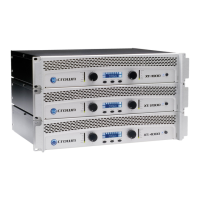CEquel Digital Systems Overview
Page 8 of 16
Part 2. If the microcontroller (U1, LPC2142) has been previously programmed.
To reprogram a device, it is first necessary to put it in bootloader mode. This is done by
shorting TP17 to ground during a power up. After the unit powers up, the ground can be removed
or left connected, doesn’t matter. (Hint: Use a test lead connected to TP5(GND) on one end and
TP17 on the other). The LCD should be blank.
Again follow the steps in Part 1 to connect the Serial interface board to J2 and open the Philips
Flash Utility.
Press the Read Device ID button. The Part ID and Boot Loader ID should be displayed. Again
follow the steps in Part 1 to send new firmware. If this does not work, there is most likely a
hardware problem, check for shorts, correct power, bridges, other hardware problem.
To verify serial flash and check the current firmware version number
At any time hold down all three front panel buttons for at least 3 seconds. This puts the amplifier
into a diagnostic mode. NOTE: While in this mode the front panel LED’s will NOT be updated.
Also, the governor is disabled. Use the Next and Prev buttons to scroll thru the displays. They
are outlined below:
Screen 1: Power Supply Temperature Sensor Read out in degrees C
Screen 2: Ch1 Temperature Sensor Read out in degrees C
Screen 3: Ch2 Temperature Sensor Read out in degrees C
Screen 4: Firmware version number read back from Serial Flash (eg. 1. 1. 0.15)
NOTE: The temperatures displayed are the raw unprocessed readings. They are updated
approximately every 600ms and should be accurate.
LCD display looks to be corrupted.
If the text on the LCD looks to be bogus, it most likely is because the serial flash is blank
or corrupt or is out of sync with the microcontroller program.
This problem can be resolved by updating the firmware via USB. This method ensures
that both the serial flash and microcontroller are reprogrammed.

